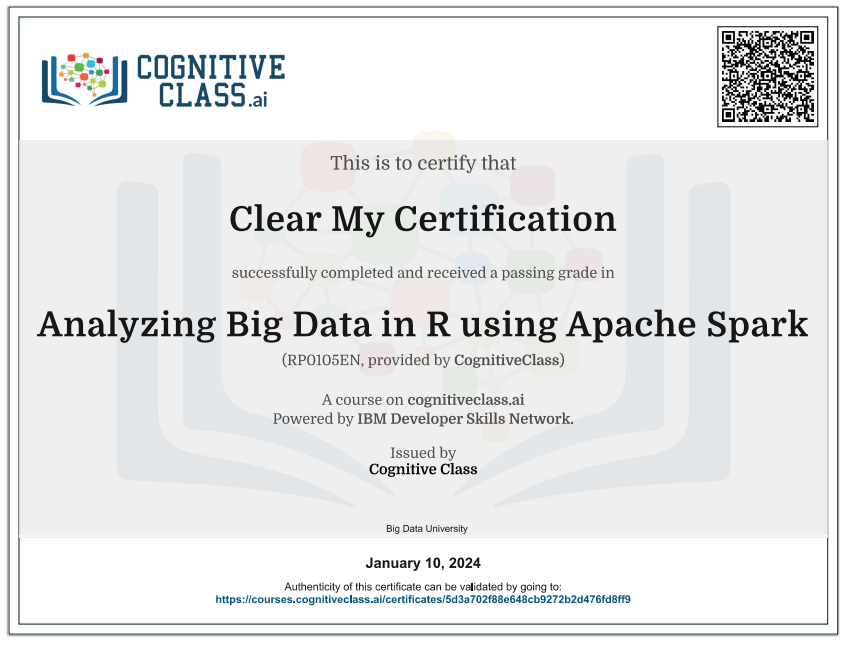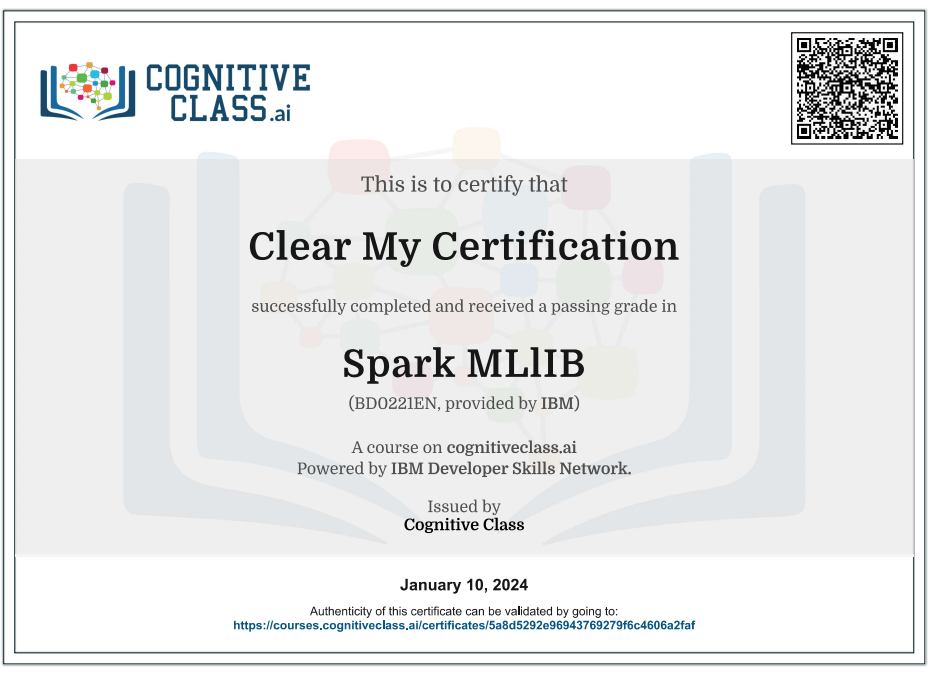Enroll Here: Data Science with Scala Cognitive Class Exam Quiz Answers
Data Science with Scala Cognitive Class Certification Answers

Module 1 – Basic Statistics and Data Types Quiz Answers – Cognitive Class
Question 1: You import MLlib’s vectors from?
- org.apache.spark.mllib.TF
- org.apache.spark.mllib.numpy
- org.apache.spark.mllib.linalg
- org.apache.spark.mllib.pandas
Question 2: Select the types of distributed Matrices:
- Row Matrix
- Indexed Row Matrix
- Coordinate Matrix
Question 3: How would you caculate the mean of the following?
val observations: RDD[Vector] = sc.parallelize(Array(
Vectors.dense(1.0, 2.0),
Vectors.dense(4.0, 5.0),
Vectors.dense(7.0, 8.0)))
val summary: MultivariateStatisticalSummary = Statistics.colStats(observations)
- summary.normL1
- summary.numNonzeros
- summary.mean
- summary.normL2
Question 4: what task does the following lines of code?
import org.apache.spark.mllib.random.RandomRDDs._
val million = poissonRDD(sc, mean=1.0, size=1000000L, numPartitions=10)
- calculate the variance
- calculate the mean
- generate random samples
- Calculate the variance
Question 5: MLlib uses the compressed sparse column format for sparse matrices, as Such it only keeps the non-zero entrees?
- True
- False
Module 2 – Preparing Data Quiz Answers – Cognitive Class
Question 1: WFor a dataframe object the method describe calculates the?
- count
- mean
- standard deviation
- ma
- min
- all of the above
Question 2: What line of code drops the rows that contain null values, select the best answer?
- val dfnan = df.withColumn(“nanUniform”, halfTonNaN(df(“uniform”)))
- dfnan.na.replace(“uniform”, Map(Double.NaN -> 0.0))
- dfnan.na.drop(minNonNulls = 3)
- dfnan.na.fill(0.0)
Question 3: What task does the following lines of code perform?
val lr = new LogisticRegression()
lr.setMaxIter(10).setRegParam(0.01)
val model1 = lr.fit(training)
- perform one hot encoding
- Train a linear regression model
- Train a Logistic regression model
- Perform PCA on the data
Question 4: The StandardScaleModel transforms the data such that?
- each feature has a max value of 1
- each feature is Orthogonal
- each feature to have a unit standard deviation and zero mean
- each feature has a min value of -1
Module 3 – Feature Engineering Quiz Answers – Cognitive Class
Question 1: Spark ML works with?
- tensors
- vectors
- dataframes
- lists
Question 2: the function IndexToString() performs One hot encoding?
- True
- False
Question 3: Principal Component Analysis is Primarily used for?
- to convert categorical variables to integers
- to predict discrete values
- dimensionality reduction
Question 4: one import set prior to using PCA is?
- normalizing your data
- making sure every feature is not correlated
- taking the log for your data
- subtracting the mean
Module 4 – Fitting a Model Quiz Answers – Cognitive Class
Question 1: You can use decision trees for?
- regression
- classification
- classification and regression
- data normalization
Question 2: the following lines of code: val Array(trainingData, testData) = data.randomSplit(Array(0.7, 0.3))
- split the data into training and testing data
- train the model
- use 70% of the data for testing
- use 30% of the data for training
- make a prediction
Question 3: in the Random Forest Classifier constructor .setNumTrees()?
- sets the max depth of trees
- sets the minimum number of classes before a split
- set the number of trees
Question 4: Elastic net regularization uses?
- L0-norm
- L1-norm
- L2-norm
- a convex combination of the L1 norm and L2 norm
Module 5 – Pipeline and Grid Search Quiz Answers – Cognitive Class
Question 1: what task does the following code perform: withColumn(“paperscore”, data(“A2”) * 4 + data(“A”) * 3)?
- add 4 colunms to A2
- add 3 colunms to A1
- add 4 to each elment in colunm A2
- assign a higher weight to A2 and A journals
Question 2: In an estimator?
- there is no need to call the method fit
- fit function is called
- transform function is only called
Question 3: Which is not a valid type of Evaluator in MLlib?
- Regression Evaluator
- Multi-Class Classification Evaluator
- Multi-Label Classification Evaluator
- Binary Classification Evaluator
- All are valid
Question 4: In the following lines of code, the last transform in the pipeline is a:
val rf = new RandomForestClassifier().setFeaturesCol(“assembled”).setLabelCol(“status”).setSeed(42)
import org.apache.spark.ml.Pipeline
val pipeline = new Pipeline().setStages(Array(value_band_indexer,category_indexer,label_indexer,assembler,rf))
- principal component analysis
- Vector Assembler
- String Indexer
- Vector Assembler
- Random Forest Classifier
Data Science with Scala Final Exam Answers – Cognitive Class
Question 1: What is not true about labeled points?
- They associate dense vectors with a corresponding label/response
- They associate sparse vectors with a corresponding label/response
- They are used in unsupervised machine learning algorithms
- All are true
- None are true
Question 2: Which is true about column pointers in sparse matrices?
- They have the same number of values as the number of columns
- They never repeat values
- By themselves, they do not represent the specific physical location of a value in the matrix
- All are true
- None are true
Question 3: What is the name of the most basic type of distributed matrix?
- Coordinate Matrix
- Indexed Row Matrix
- Simple Matrix
- Row Matrix
- Sparse Matrix
Question 4: A perfect correlation is represented by what value?
- 100
- 3
- 1
- 0
- -1
Question 5: A MinMaxScaler is a transformer which:
- Rescales each feature to a specific range
- Takes no parameters
- Makes zero values remain untransformed
- All are true
- None are true
Question 6: Which is not a supported Random Data Generation distribution?
- Exponential
- Uniform
- Delta
- Normal
- Poisson
Question 7: Sampling without replacement means:
- The expected size of the sample is the same as the RDDs size
- The expected number of times each element is chosen is randomized
- The expected size of the sample is unknown
- The expected size of the sample is a fraction of the RDDs size
- The expected number of times each element is chosen
Question 8: What are the supported types of hypothesis testing?
- Kolmogorov-Smirnov test for equality of distribution
- Pearson’s Chi-Squared Test for goodness of fit
- Pearson’s Chi-Squared Test for independence
- All are supported
- None are supported
Question 9: For Kernel Density Estimation, which kernel is supported by Spark?
- KDEMultivariate
- KDEUnivariate
- KernelDensity
- Gaussian
- All are supported
Question 10: Which DataFrames statistics method computes the pairwise frequency table of the given columns?
- freqItems()
- crosstab()
- cov()
- pairwiseFreq()
- corr()
Question 11: Which is not true about the fill method for DataFrame NA functions?
- It is used for replacing null values
- It is used for replacing nil values
- It is used for replacing NaN values
- All are true
- None are true
Question 12: Which transformer listed below is used for Natural Language Processing?
- OneHotEncoder
- ElementwiseProduct
- Normalizer
- StandardScaler
- None are used for Natural Language Processing
Question 13: Which is true about the Mahalanobis Distance?
- It is a scale-variant distance
- It is a multi-dimensional generalization of measuring how many standard deviations a point is away from the median
- It is measured along each Principle Component axis
- It has units of distance
- It does not take into account the correlations of the dataset
Question 14: Which is true about OneHotEncoder?
- It creates a Sparse Vector
- It must be told which column to create for its output
- It must be told which column is its input
- All are true
- None are true
Question 15: Principle Component Analysis is:
- A dimension reduction technique
- Is never used for feature engineering
- Used for supervised machine learning
- All are true
- None are true
Question 16: MLlib’s implementation of decision trees:
- Partitions data by rows, allowing distributed training
- Supports only multiclass classification
- Does not support regressions
- Supports only continuous features
- None are true
Question 17: Which is not a tunable of SparkML decision trees?
- maxMemoryInMB
- minInfoGain
- minDepth
- maxBins
- minInstancesPerNode
Question 18: Which is true about Random Forests?
- They support non-categorical features
- They combine many decision trees in order to reduce the risk of overfitting
- They do not support regression
- They only support binary classification
- None are true
Question 19: When comparing Random Forest versus Gradient-Based Trees, what must you consider?
- Parallelization abilities
- Depth of Trees
- How the number of trees affects the outcome
- All of these
- None of these
Question 20: Which is not a valid type of Evaluator in MLlib?
- Multi-Class Classification Evaluator
- Binary Classification Evaluator
- Regression Evaluator
- Multi-Label Classification Evaluator
- All are valid
Introduction to Data Science with Scala
Scala is a versatile programming language that runs on the Java Virtual Machine (JVM), making it compatible with existing Java libraries and frameworks. When it comes to data science, Scala can be a powerful choice, especially when combined with popular data processing and machine learning libraries. Here are some key aspects of doing data science with Scala:
- Apache Spark:
- Scala is the primary language for Apache Spark, a fast and distributed data processing engine. Spark provides APIs in Scala, Java, Python, and R, but Scala’s concise syntax and functional programming features make it a popular choice for Spark development.
- Spark allows you to perform distributed data processing, machine learning, graph processing, and more. You can use Spark’s DataFrame API or the lower-level RDD API for data manipulation.
- Scala Libraries for Data Science:
- Breeze: Breeze is a numerical processing library for Scala that provides support for linear algebra, statistics, and signal processing. It can be used for various data manipulation and analysis tasks.
- Smile: Smile is a machine learning library for Scala and Java. It includes a variety of algorithms for classification, regression, clustering, and dimensionality reduction.
- Algebird: Algebird is a library for abstract algebra for Scala, and it can be useful for creating scalable and efficient data processing pipelines.
- DataFrames and Datasets:
- In addition to Spark, libraries like Apache Flink also support Scala for distributed stream and batch processing. Flink’s Table API and SQL support can make it easy to work with data using familiar SQL-like queries.
- Deep Learning with Scala:
- Libraries like Deeplearning4j provide support for deep learning in Scala. Deeplearning4j is designed for Java and Scala compatibility, making it suitable for JVM-based languages.
- Interactive Data Analysis:
- Scala can be used interactively for data analysis using tools like Jupyter notebooks with the Scala kernel or Zeppelin notebooks. These notebooks allow you to combine code, visualizations, and narrative text in a single document.
- Data Visualization:
- For data visualization, you can use Scala libraries like Breeze-viz or integrate with popular Java visualization libraries. Alternatively, you can export data to be visualized in other tools like Python-based Matplotlib or Plotly.
- Data Management and Processing:
- Scala can be used for ETL (Extract, Transform, Load) tasks and data processing. Apache Kafka, a distributed streaming platform, has a Scala API that can be used for building real-time data pipelines.
- Concurrency and Parallelism:
- Scala’s support for functional programming and its Actor model for concurrency make it well-suited for handling parallel processing tasks in data science.
When working with Scala for data science, it’s essential to leverage its functional programming features, which can lead to more concise and expressive code. Additionally, familiarity with the Apache Spark ecosystem is crucial, as it is a prevalent framework for large-scale data processing and analytics using Scala.
 Clear My Certification All Certification Exam Answers
Clear My Certification All Certification Exam Answers



